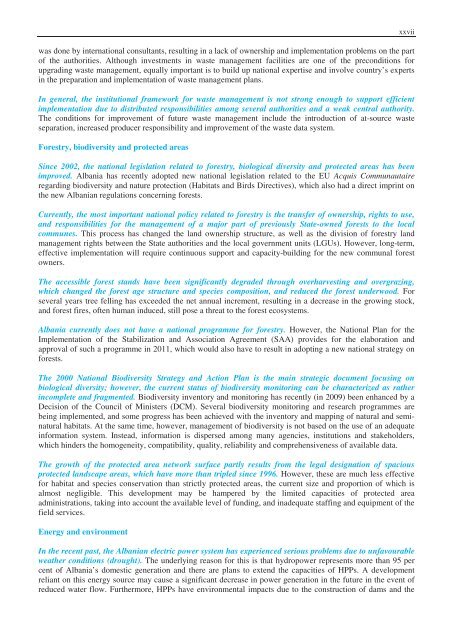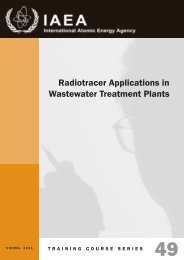Second Environmental Performance Review of Albania
Second Environmental Performance Review of Albania
Second Environmental Performance Review of Albania
Create successful ePaper yourself
Turn your PDF publications into a flip-book with our unique Google optimized e-Paper software.
was done by international consultants, resulting in a lack <strong>of</strong> ownership and implementation problems on the part<strong>of</strong> the authorities. Although investments in waste management facilities are one <strong>of</strong> the preconditions forupgrading waste management, equally important is to build up national expertise and involve country’s expertsin the preparation and implementation <strong>of</strong> waste management plans.In general, the institutional framework for waste management is not strong enough to support efficientimplementation due to distributed responsibilities among several authorities and a weak central authority.The conditions for improvement <strong>of</strong> future waste management include the introduction <strong>of</strong> at-source wasteseparation, increased producer responsibility and improvement <strong>of</strong> the waste data system.Forestry, biodiversity and protected areasSince 2002, the national legislation related to forestry, biological diversity and protected areas has beenimproved. <strong>Albania</strong> has recently adopted new national legislation related to the EU Acquis Communautaireregarding biodiversity and nature protection (Habitats and Birds Directives), which also had a direct imprint onthe new <strong>Albania</strong>n regulations concerning forests.Currently, the most important national policy related to forestry is the transfer <strong>of</strong> ownership, rights to use,and responsibilities for the management <strong>of</strong> a major part <strong>of</strong> previously State-owned forests to the localcommunes. This process has changed the land ownership structure, as well as the division <strong>of</strong> forestry landmanagement rights between the State authorities and the local government units (LGUs). However, long-term,effective implementation will require continuous support and capacity-building for the new communal forestowners.The accessible forest stands have been significantly degraded through overharvesting and overgrazing,which changed the forest age structure and species composition, and reduced the forest underwood. Forseveral years tree felling has exceeded the net annual increment, resulting in a decrease in the growing stock,and forest fires, <strong>of</strong>ten human induced, still pose a threat to the forest ecosystems.<strong>Albania</strong> currently does not have a national programme for forestry. However, the National Plan for theImplementation <strong>of</strong> the Stabilization and Association Agreement (SAA) provides for the elaboration andapproval <strong>of</strong> such a programme in 2011, which would also have to result in adopting a new national strategy onforests.The 2000 National Biodiversity Strategy and Action Plan is the main strategic document focusing onbiological diversity; however, the current status <strong>of</strong> biodiversity monitoring can be characterized as ratherincomplete and fragmented. Biodiversity inventory and monitoring has recently (in 2009) been enhanced by aDecision <strong>of</strong> the Council <strong>of</strong> Ministers (DCM). Several biodiversity monitoring and research programmes arebeing implemented, and some progress has been achieved with the inventory and mapping <strong>of</strong> natural and seminaturalhabitats. At the same time, however, management <strong>of</strong> biodiversity is not based on the use <strong>of</strong> an adequateinformation system. Instead, information is dispersed among many agencies, institutions and stakeholders,which hinders the homogeneity, compatibility, quality, reliability and comprehensiveness <strong>of</strong> available data.The growth <strong>of</strong> the protected area network surface partly results from the legal designation <strong>of</strong> spaciousprotected landscape areas, which have more than tripled since 1996. However, these are much less effectivefor habitat and species conservation than strictly protected areas, the current size and proportion <strong>of</strong> which isalmost negligible. This development may be hampered by the limited capacities <strong>of</strong> protected areaadministrations, taking into account the available level <strong>of</strong> funding, and inadequate staffing and equipment <strong>of</strong> thefield services.Energy and environmentIn the recent past, the <strong>Albania</strong>n electric power system has experienced serious problems due to unfavourableweather conditions (drought). The underlying reason for this is that hydropower represents more than 95 percent <strong>of</strong> <strong>Albania</strong>’s domestic generation and there are plans to extend the capacities <strong>of</strong> HPPs. A developmentreliant on this energy source may cause a significant decrease in power generation in the future in the event <strong>of</strong>reduced water flow. Furthermore, HPPs have environmental impacts due to the construction <strong>of</strong> dams and thexxvii
















